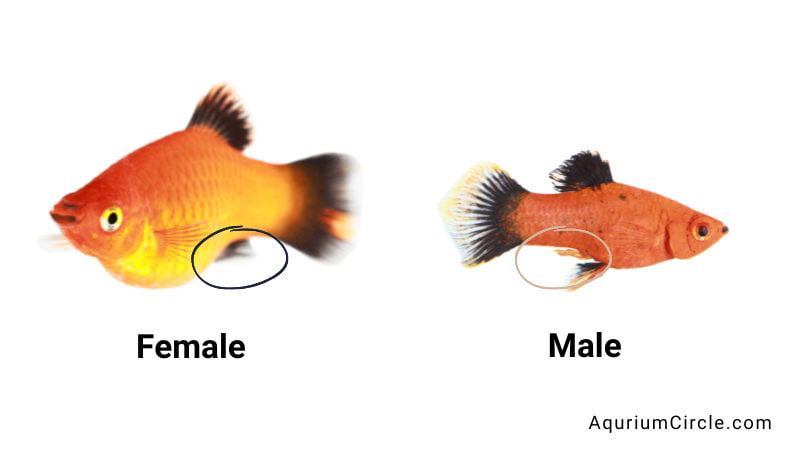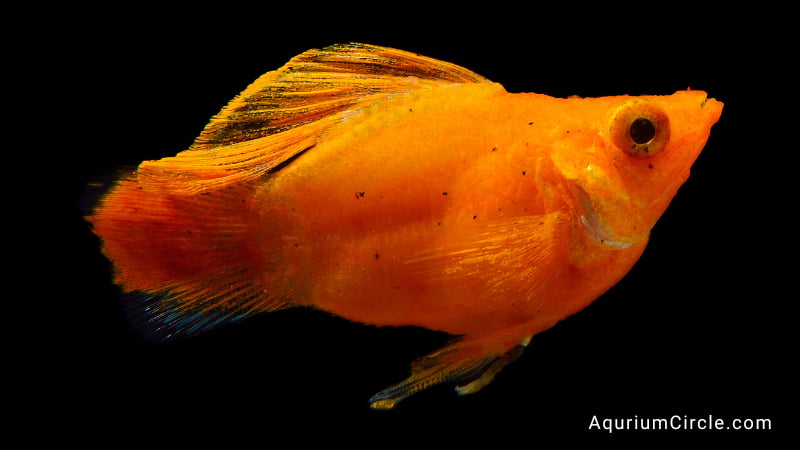Gentle and attractive, colorful and multi-shaped, Mollies are always good for beginners, even for professional breeders.
Keeping them all in a crowded tank, on the other hand, is a recipe for trouble. This situation can deteriorate if you do not know how to clearly identify their gender. Yes, most cases show that a male Molly fish is aggressive toward other males and initiates a terrible fight with one of them, even though all are beaten and injured. No one wants this to happen as fish lovers and aquarium enthusiasts. So, keeping 1 male Molly fish and 3 females is the suitable ratio.
In this post, we’ll go over how to tell the difference between a female and a male molly fish based on physical and behavioral characteristics, what you should do, and what you should avoid to ensure Mollies have a happy life.
Male Molly Fish Characteristics?
Male Molly fish can be distinguished from females by a variety of distinguishing traits. Its gonopodium, a modified anal fin used to fertilize the female during mating, is one of the most obvious characteristics. The gonopodium, which has a curved form that aids in sperm delivery to the female’s eggs, is longer and thinner than the anal fin of the female.
Male Molly fish typically have larger dorsal fins and more vibrant markings than females in addition to the gonopodium. Their body shapes might be more sleek and slim. Overall, male Molly fish are physically appealing and essential to breeding and preserving a robust population in aquariums.
Are Male Mollies Aggressive?
Yes, they are. Male mollies are sometimes hostile, particularly to other males. If the females are not interested in mating, they may also harass them.
However, the degree of violence can differ across people and can also be impacted by elements like the tank’s size, the quantity of fish, and the existence of plants and hiding places. In order to lessen aggression, it is typically advised to have a ratio of more females to males in the tank. Having lots of room and hiding places might also lessen hostility.
How To Identify Male And Female Molly Fish?
Colors
Mollies come in a variety of colors due to the wide variety of species, but you can tell which one is a male merely by looking at its color. Mollies’ male pigmentation patterns tend to be more vibrant and striking than those of their female counterparts. Female mollies, on the other hand, have bland, timid, and modest hue schemes, which is why the stronger color variants of lad mollies appear to be appealing. It also attracts female mollies to mate with each other.
In nature, you’re likely to come into this situation on a regular basis. Please spare a few minutes to observe. Isn’t it amazing?
Size & shape
Generally, females are larger than males. Depending on the species, they can grow to a maximum size of 5 inches, while males remain in the 2.5-3.5-inch range.
On the other hand, males seem bigger if they suffer from conditions that induce bloating. Overeating and constipation are the first two possibilities to consider, particularly if you leave food floating on the top of the tank after your fish have had two to three minutes to feed. Other physical causes of flotation issues include fatty liver disease and kidney disorders. The only way forward is to determine the cause and treat him as quickly as possible.
Dorsal fin

Mollies’ dorsal fin is their back fin. Male and female mollies both have a dorsal fin that serves to enhance their appearance, however, male mollies often have a larger dorsal fin than females.
Males’ dorsal fins are typically three to four times larger than females. This is a remarkable trait that is immediately apparent.
Reason? Male molly fish with dorsal fins appear larger and more threatening to other males due to the dorsal fin. The female will then examine the male’s dorsal fin size, among other factors, when choosing who to mate with. You could say that this is a significant issue for him.
Anal fin
Male molly fish have a thorn-shaped fin that never expands wide like the females’, whereas the females’ anal fins are larger and slightly longer. Males have gonopodium on their anal fins, which is why this is the case. Most fish species have this organ only in males.
It is through the use of these copulatory organs that the sexes exchange sperm during the act of mating. Although the size of the gonopodium may vary based on the male’s size and developmental stage, it is always narrow and pointed at the end. To top it all off, this organ will preserve both the male and female fish’s dorsal and caudals in their original hues.
How Does Molly Fish Behaviors Of Mate?
As previously stated, males have gonopodium on their anal fins (it resembles a slender rod) that enables male fish of the families Anablepidae and Poeciliidae to temporarily hook into a female fish’s vent and deposit sperm. Normally, this fin is held back, but the male fish lowers and forwards it immediately before mating. These guys can be so bad by doing this act frequently when do care their females are gravid or even nearly drop young. But, they pay court to all, and sundry, immature males are included.
A molly fish’s gestation span is approximately 60 days. Female mollies can retain sperm for months and can fertilize eggs as frequently as every 30 days, even in the absence of a male in the tank. Males can begin breeding at roughly 12 months of age. Females can begin breeding at the age of six months.
How To Know If Molly Is Pregnant?
Another feature for distinguishing your female and male molly fish apart is the time before they are pregnant.
The gravid spot is a darker pigmentation observed in the female belly. About halfway through pregnancy, the gravid patch appears in the lower belly, near the cloaca (around 14 days in). This is a common occurrence in livebearers, as only female mollies may become pregnant. Toward the conclusion of pregnancy, the gravid spot will develop in size and intensity (darken).
When the female is about to deliver, some molly keepers claim you can see the fry’s eyes in the same location.
Why Two Male Mollies Fighting?
There are two reasons for this. The first reason, a male Molly fish can be aggressive and tend to fight for being a winner and mating with females. Last but not least, the problem is that your tank is too small. As a result, they are unable to establish their own area.
The section below will be guidelines for resolving these issues, also tips to build a happy life for your males.
Can goldfish and mollies live together?
Yes, but not recommend it. Goldfish and mollies have different temperature and water quality requirements, so they are not typically to be kept together in the same aquarium. Goldfish prefer cooler water temperatures between 65-72°F (18-22°C), while mollies prefer warmer water temperatures between 75-82°F (24-28°C).
Additionally, goldfish produce a lot of waste, which can create poor water quality if not properly filtered, while mollies are more tolerant of slightly higher nitrate levels. In general, it is best to keep fish with similar temperature and water quality preferences together in the same tank to ensure their health and well-being.
FAQs
Are female mollies bigger than males?
Yes, in general, female mollies tend to be larger and wider than males. Females also have rounded abdomens, while males have a pointed gonopodium used for mating. However, the size difference between males and females can vary depending on the species and individual fish.
Can I keep all male mollies?
No, it is generally not recommended to keep all male mollies together as they can become aggressive towards each other, especially during the breeding season. Without female mollies to mate with, males may also become more aggressive and territorial towards other tank mates. Therefore, it is recommended to keep a ratio of at least one female to every two males in a molly fish tank.
Why is my male molly chasing the female?
Male mollies are known to chase females as a part of their mating behavior. During the breeding season, male mollies become more aggressive in their pursuit of females, often displaying courtship behavior such as flaring fins and swimming alongside the female
Are mollies easy to raise?
Mollies are relatively easy to breed, but successful nurturing depends on providing the right conditions. Males and females need to be kept together in a tank with a good water quality and temperature. The tank should also have plenty of hiding spots for the female to avoid harassment from the male.
References
- Poecilia sphenops – https://en.wikipedia.org/wiki/Poecilia_sphenops
- Mollies – https://freshwaterfish.fandom.com/wiki/Mollies

Annette M. Chaney is an experienced marine biologist with over 20 years of experience as an aquarist and fishkeeper. She started her first aquarium at a young age, filling it with frogs and goldfish obtained from the ten-cent pet store.
Annette grew up caring for and breeding African Cichlids, which led to a hobby in high school that doubled as a profitable means. Attending Reed College gave her time to solidify herself as an accomplished aquarium caretaker with an eye for sales. After that, from 2009 – 2013, she studied at Roger Williams University – one of the most prestigious universities for Aquaculture and Aquarium in USA. She is the founder of AquariumCircle since 2010.
